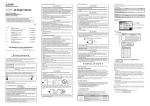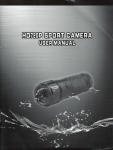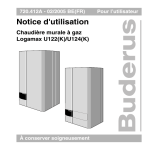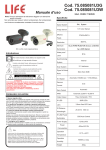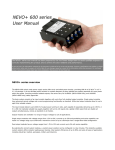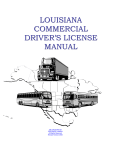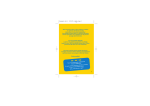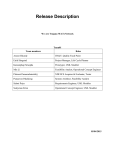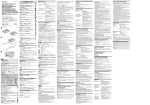Download Velleman DCM270 multimeter
Transcript
Info ormation n sheet Safety y inforrmation for Digital D Volt M Meters ( (DVMs ) 1. 2. 3. 4. Symbols s used on DVMs an nd in man nuals Overvolttage/insta allation ca ategories Pollution n degree General mbols us sed on DVMs and a in manual m s 1. Sym ndicates: Read R instr ructions This symbol in r the e instruction ns and man nual can lea ad to dama age, injury or o Not reading death h. This symbol in ndicates: Danger D A haz zardous condition or acttion that ma ay result in n injury or death d ndicates: Risk R of dan nger/dam mage This symbol in dous condittion or actio on that may y result in damage, in njury Risk of a hazard eath or de This symbol in ndicates: A Attention; importan nt informattion Ignoring this infformation can c lead to hazardous s situations. AC (A Alternating Current) DC (Direct Currrent) Both AC and DC C ble insulatio on (class II-protection n) Doub h Earth Fuse Capa acitor e Diode Continuity Vellema an® 1/3 La ast update: 31/0 03/2010 Information sheet 2. Overvoltage/installation categories DVMs are categorized depending on the risk and severity of transient overvoltage that might occur at the point of test. Transients are short-lived burst of energy induced in a system, e.g. caused by lightning strike on a power line. On high-energy circuits this leads to hazardous situations as these circuits might provide enough current to feed an arc-over resulting in a plasma breakdown or even explosion. Higher CAT-identification refers to electrical environments with higher power and possibly higher energy transients. A CAT I-rated meter is suitable for measurements on protected electronic circuits that are not directly connected to mains power, e.g. electronics circuits, control signals… Velleman® A CAT II-rated meter is suitable for measurements in CAT I-environments and mono-phase appliances that are connected to the mains by means of a plug and circuits in a normal domestic environment, provided that the circuit is at least 10m apart from a CAT III- or 20m apart from a CAT IVenvironment. E.g. household appliances, portable tools… A CAT III-rated meter is suitable for measurements in CAT I- and CAT IIenvironments, as well as for measurements on (fixed) mono- or poly-phased appliances which are at least 10m apart from of a CAT IVenvironment, and for measurements in or on distribution level equipment (fuse boxes, lighting circuits, electric ovens). 2/3 A CAT IV-rated meter is suitable for measuring in CAT I-, CAT II- and CAT IIIenvironments as well as on the primary supply level. Note that for all measurements on equipment for which the supply cables run outdoors (either overhead or underground) a CAT IV meter must be used. Last update: 31/03/2010 Info ormation n sheet 3. Polllution degree d IEC 61010-1 spe ecifies different types of pollution n environments, for w which differe ent ctive measu ures are ne ecessary to ensure saffety. Harsher environm ments requ uire protec more protection,, and the protection against the pollution which w is to b be found in a certain environm ment depends mainly on o the insulation and the enclosu ure propertties. gree rating of the DVM M indicates s in which environmen e nt the devic ce may The pollution deg ed. be use Pollution degree 1 No pollu ution or onlly dry, nonconductive pollution o occurs. The pollution has no in nfluence. (o only to be fo ound in herrmetically sealed s enclosures) Pollution degree 2 Only no onconductiv ve pollution occurs. Oc ccasionally,, temporary y conducttivity cause ed by conde ensation is to be expe ected.(home e and office environmentts fall unde er this categ gory) Pollution degree 3 Conductive pollutio on occurs, or dry nonc conductive pollution occurs o comes cond ductive due e to conden nsation thatt is to be that bec expecte ed. (industrrial environ nments and environme ents expose ed to outsid de air - but no ot in contac ct with prec cipitation) Pollution degree 4 The pollution gene erates persiistent conductivity cau used by door conducttive dust orr by rain orr snow. (exposed outd environments and environme ents where high humid dity levels or o ns of fine pa articles occ cur) high concentration 4. Gen neral W Warnin g - Ca aution n • • • • • • • • • • Disconnect the D t test lea ads from the test pointts before ch hanging the e position of o the fu unction (rottary) switch h. D Disconnect t the test lea ads from the test pointts and remove the tes st leads from the m measuring terminals be efore replac cing the ba atteries/fuse es, or servicing the DV VM. W WARNING: To avoid electrical e sh hock alway ys disconne ect the testt leads priorr to opening the housing. To T prevent damage d or injury, only use batte eries and fu uses w with the sam me ratings as a specified d in this ma anual. Never conne ect a voltag ge source with w the fun nction (rotary) switch in Ω / / / µA / mA / A / Hz / Hffe or °C/°F position. C Caution: ris sk of electro oshock whe en measurin ng voltages > 36VDC, 25VAC, currrents > 10mA, AC C power line es with indu uctive loads and AC power lines w with fluctuatting po ower. A Avoid body contact witth ground potential p (e..g. metallic terminals, output soc ckets, le ead clamp… …) while mea asuring. Ma ake sure to be electrica ally insulate ed from gro ound during meas surement. A Always use the device within its specified s range. O Only use the e included test t leads. When W dama aged, replace them wiith test lead ds of th he same typ pe and with h the same specificatio ons. Calibration and a repair must m be perrformed by a qualified technician.. Refer to your y ocal dealer. lo D not expo Do ose the DVM M to extrem me tempera ature or hum midity levels. Vellema an® 3/3 La ast update: 31/0 03/2010



